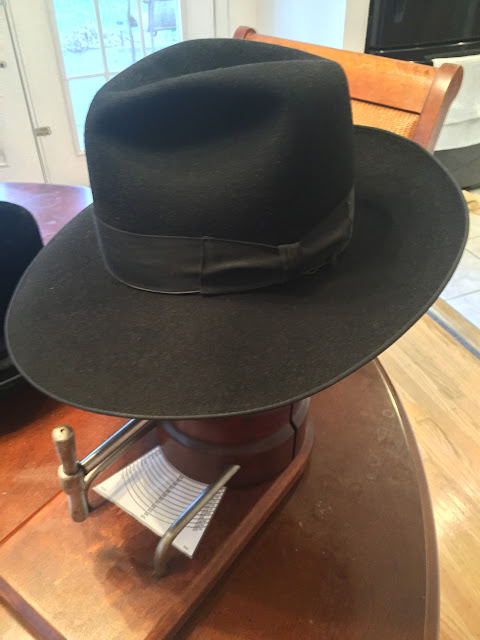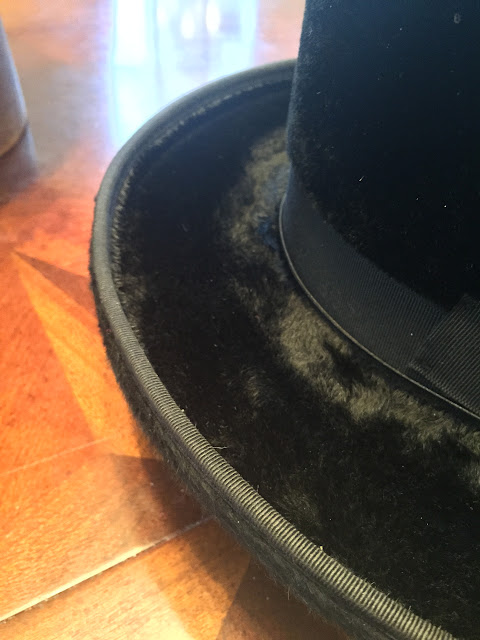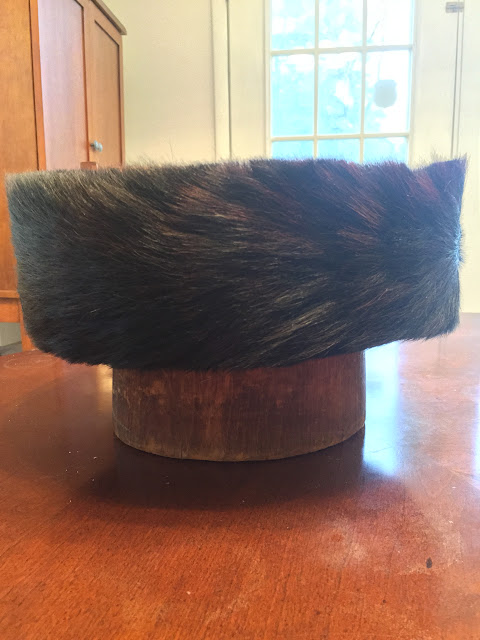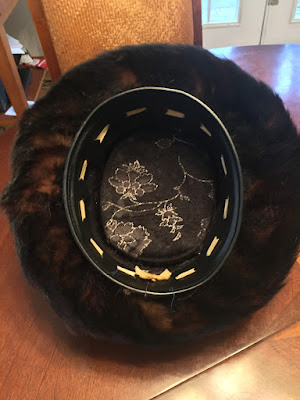Joshua London
New in Town
- Messages
- 32
A fellow landsman? Or you just like the style (black, wide-brimmed, made for the religious market)? ;-)
A fellow landsman? Or you just like the style (black, wide-brimmed, made for the religious market)? ;-)

Beyond eBay, and I guess local shops, where does one find used hats? I wear a U.S. size 7 & 1/2 (head is 59.7 cm; 23 & 1/2 inches), I can rarely find anything in my size that is still in decent enough nick....These hats are of good quality and can be found at attractive prices on the used market.
Beyond eBay, and I guess local shops, where does one find used hats? I wear a U.S. size 7 & 1/2 (head is 59.7 cm; 23 & 1/2 inches), I can rarely find anything in my size that is still in decent enough nick.

Makes good sense!...Since I’m going to convert them into more traditional fedoras and don’t want the really wide brims, I can reblock them up to my size at the expense of brim width.
Beyond eBay, and I guess local shops, where does one find used hats? I wear a U.S. size 7 & 1/2 (head is 59.7 cm; 23 & 1/2 inches), I can rarely find anything in my size that is still in decent enough nick.
Try the classifieds thread.Beyond eBay, and I guess local shops, where does one find used hats? I wear a U.S. size 7 & 1/2 (head is 59.7 cm; 23 & 1/2 inches), I can rarely find anything in my size that is still in decent enough nick.

In my neck of the woods, black hat and beard are more likely to be mistaken as "Amish".
Thanks for the tutorial Aaron. I, like others here enjoy learning about other cultures, religions, customs. If hat wearing is involved, even more so...
I never thought of that, but it makes a lot of sense.Another cultural-origin data point that I have heard is that the overall style of dress that you see on these guys basically is what was in fashion in their ancestral eastern-european countries at the time that their ancestors emigrated, and once over here the style just kind of stuck.
When you live for two main reasons - God and family, pretty much everything else is less than secondary.
Plain black and white clothing is about as modest as it gets, and if you're not one to keep up with trends (people who are extreeeemely devout), then you stay with traditional - what's been worn by your parents, grandparents, etc, clothing.
You know - Traditiooooooon, tradition . . . tradition!
Yeah, but if I were a rich man....
 John Lofgren Monkey Boots Shinki Horsebuttt - $1,136 The classic monkey boot silhouette in an incredibly rich Shinki russet horse leather.
John Lofgren Monkey Boots Shinki Horsebuttt - $1,136 The classic monkey boot silhouette in an incredibly rich Shinki russet horse leather.  Grant Stone Diesel Boot Dark Olive Chromexcel - $395 Goodyear welted, Horween Chromexcel, classic good looks.
Grant Stone Diesel Boot Dark Olive Chromexcel - $395 Goodyear welted, Horween Chromexcel, classic good looks.  Schott 568 Vandals Jacket - $1,250 The classic Perfecto motorcycle jacket, in a very special limited-edition Schott double rider style.
Schott 568 Vandals Jacket - $1,250 The classic Perfecto motorcycle jacket, in a very special limited-edition Schott double rider style. Sorry, Charlie....Scotty started it.
how you clean the high crown hats?On occasion the question of Jewish hats comes up, and since an off-topic post I made in a different thread generated a little interest, I'll share more here. Ignore it if you want; ask me any questions you want.
Realistically, when we're talking about black hats worn by Jews, we're talking only about the most Orthodox and Ultra-Orthodox groups; the largest Jewish streams in the United States, Conservative and Reform Judaism have no tradition of hat-wearing, and even the Modern Orthodox generally do not wear hats (beside the kippah, or yarmulke, the skullcap men tend to wear).
For most of us, the broad-brimmed black fedora is the one that causes the most, "Hey, are you Jewish?" responses.

Tending to be 3"+ in brim, these black fedoras are not uncommon in traditional Orthodox communities or among a group of Hasidim called Chabad Lubavitch. They tend to be Borsalinos or Huckels (or other non-specific Czech/Polish hatmakers), and they're just fedoras. Mine's a Borsalino with a 3.5-ish" brim. A hat like this will set you back anywhere from $100-$400.

You'll notice the wide brim and a relatively high crown; brims tend to have a pretty good snap in the front, although they can be flanged any way you'd like.
Next, let's look at a type of hat called a "hoiche" or high-crowned hat. "Hoiche" is Yiddish for high. Most Hasidim wear a higher hat like this, with only a few of the courts favoring the lower-crowned "flacha" style of hat ("flacha" is Yiddish for flat).


You can see here the long nap of the felt and the stand-up bound-brim:

This one is made in China and imported through Brooklyn. The hat is really, really stiff, more like a bowler rather than a fedora. These hats are made to sit higher on the head than a fedora might, so keep that in mind if you're ever thinking of getting one. The resting line on your head plus the hard felt means they're not forgiving size-wise.


You can see how the ribbon cuts into the nap of the felt, making it look like a belt almost. The flacha hat is very similar, but with about 2" of crown taken off. These hats will run you $50-$200.
The final hat you might have seen or heard about is called a shtreimel. These are very furry, very special hats usually only worn by the Ultra-Orthodox, and only on Friday night into Saturday, the Jewish Sabbath, or on Jewish holidays.



Made of fox fur on the outer round part and on the inner part, the shtreimel looks like a crown, according to some stories. Between the inner fur and the outer fur is a firm band of felt on to which the outer fox fur is placed to give the hat shape and structure. The inside, you can see, is a sort of velvet-felt combination.

Shtreimels are also worn higher on the head than a fedora. If you get one new--which I most certainly did not--you'll pay anywhere from $1500 to $5000 for one of these hats. Used ones come up occasionally on auction sites.

Remember, most Jews in the U.S., and indeed, non-Orthodox Jews throughout the world don't wear hats like these--or hats at all, truth be told.
So there you go! Hope that helps, and if you have questions, please feel free to let me know.
A
how you clean the high crown hats?